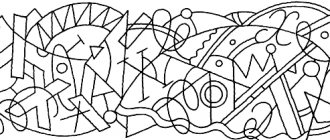Characteristics of violations of the lexico-grammatical aspect of speech in OHP
Psychological and pedagogical characteristics of children with ODD (etiology, classification) Read more: Directions of work to eliminate violations of the lexico-grammatical structure of speech in children
1.3 Characteristics of violations of the lexico-grammatical aspect of speech in OHP
R.I. Lalaeva and N.V. Serebryakov describe in detail lexical disorders in children with ODD, noting the limited vocabulary, the discrepancy between the volume of active and passive dictionaries, inaccurate use of words, verbal paraphasia, unformed semantic fields, and difficulties in updating the dictionary. [11] One of the pronounced features of the speech of children with ODD is the discrepancy in the volume of passive and active vocabulary: children understand the meanings of many words, the volume of their passive is sufficient, but the use of words in speech is very difficult.
The poverty of the active vocabulary is manifested in the inaccurate pronunciation of many words - the names of berries, flowers, wild animals, birds, professions, parts of the body and face. The verb dictionary is dominated by words denoting daily everyday actions. Words that have a generalized meaning and words denoting the assessment, condition, quality and attribute of an object are difficult to assimilate. Words are understood and used inaccurately, their meaning is unevenly expanded, or, on the contrary, it is understood too narrowly.
With OHP, the formation of grammatical structure occurs with greater difficulties than mastering a dictionary: the meaning of grammatical forms is more abstract, the rules for the grammatical change of words are diverse. Mastery of grammatical forms of inflection, methods of word formation, and various types of sentences occurs in children with OSD in the same sequence as with normal speech development; insufficiency of the grammatical structure is manifested in a slower pace of assimilation of the laws of grammar, in the disharmony of the development of the morphological and syntactic systems of the language.
In the works of N.S. Zhukova, L.F. Spirova, T.B. Filicheva, S.N. Shakhovskaya identified the following disorders of the morphological system of language in children with ODD:
This is a misnomer:
– endings of nouns, pronouns, adjectives;
– case and generic endings of cardinal numerals;
– ending verbs in the past tense;
– prepositional case constructions.
Violation of the syntactic structure of a sentence is expressed in the omission of sentence members, incorrect word order, and the absence of complex constructions.
Characteristics of the lexical and grammatical aspects of speech in level III OHP:
An extensive vocabulary, the presence of correctly constructed sentences, and a smaller variety of phonetic defects make the oral speech of these children more complete. Such children do not have noticeable, crudely expressed lexical-grammatical and phonetic difficulties. They reveal only more subtle signs of still unformed speech (in the analysis, as a rule, there are indications of a late onset of speech and deviations in its development).
Speech cannot be called fully formed. This is evidenced by quite frequent examples of inaccurate use of words (put stew instead of “poured stew”, long jug instead of “tall jug”, etc.), ungrammatical construction of many phrases: omission of prepositions, incorrect agreement in gender, number (for example: flies bit, the crane came, they planted the fly, all over the plate, etc.).
Deviations in vocabulary and grammar are more noticeable in a situation of conditioned speech, when the free choice of words and grammatical forms is limited. In contrast, in free speech adaptive attempts are possible to “bypass” difficult words, notice them as more familiar and proven, supplement words with gestures, etc.
The limitations of vocabulary are revealed if children are asked to name objects that go beyond the boundaries of everyday life. At the same time, it turns out that children do not name many objects at all, for example: window sill, sieve, watering can, whatnot, etc. A number of objects are indicated incorrectly or using paraphrase, for example, the pronunciation is not conveyed: oar - rake, locomotive - train, cart - sleigh, gingerbread - steering wheel, etc.
At the level of “expanded speech”, children have a relatively large stock of verbs, but less common actions in the situation of conditioned speech are called incorrectly. For example, instead of cutting, he tears paper, forges - cousnes saws out a horseshoe, knits - sews, etc.
Word replacements occur both in meaning and in sound.
In the free speech of children at this level, simple, uncommon sentences predominate. Agrammatisms are common.
1. Incorrect gender agreement:
two berries - two berries, two chairs - two chairs, two ears - two ears, a red bucket - a red bucket, a dog leaves his house - a dog leaves his house.
2. Incorrect use of the verb:
let the princess cut me off (fall in love), she stopped crying (crying), the girl looks from the house (looks out from the house).
3. Violation of agreements including:
little red flags (red), mushrooms growing (growing), palta standing (standing),
4. Incorrect use of case endings:
from the nest - from the nest, along the road - along the road, a girl walks with a briefcase - a girl walks with a briefcase, many houses - many houses, many people - many people.
5. Incorrect use of prepositions and conjunctions:
The dog leaves his home - the dog leaves the kennel, the cow leaves the barn - the cow leaves the barn.
Lexico-grammatical difficulties are especially noticeable; at this level of speech development, in many cases they cannot pronounce the plural form of a word presented in the singular, and vice versa.
Grammatical forms are indistinguishable. For example, case endings that express the transitivity of an action (accusative case) and the instrumentality of an action (the instrumental case) are poorly understood.
The understanding of morphological elements expressing the number of nouns and adjectives is not fully formed. It is not always possible to understand the morphological elements that express the meaning of the gender of the noun (in the development of the neuter) and the gender of the verb. [13]
Thus, in the lexico-grammatical structure of the speech of children with level III SEN, the following features in vocabulary are distinguished:
1. The discrepancy between the volume of active and passive vocabulary; the active vocabulary is dominated by nouns and verbs.
2. Agrammatisms are noted.
In the grammatical structure of speech:
1. Omitting clause members in a sentence.
2. Incorrect word order.
3. Absence of complex structures.
2. Identification of violations of the lexico-grammatical structure of speech in children, their correction
2.1 Methodology for examining the lexico-grammatical structure of speech in children with special needs development
The examination of children of different age groups and different degrees of learning will be structured differently, Gribova O.E. when examining the lexico-grammatical structure of speech, he proposes the following principles:
1. The principle of an individual and differentiated approach assumes that the selection of tasks, their formulation and filling with verbal and non-verbal material should be correlated with the level of the child’s real psycho-speech development and take into account the specifics of his social environment and personal development.
2. It is rational to conduct research in the direction from the general to the specific. First, the specialist identifies problems in the child’s speech development, and then these problems are examined more closely and subjected to quantitative and qualitative analysis.
3. Within each type of testing, the presentation of material is given from complex to simple. This allows the child to complete each test successfully, which creates additional motivation and a positive emotional state, which, in turn, increases the productivity and duration of the examination.
4. From productive types of speech activity to receptive ones. Based on this principle, first of all, such types of speech activity as speaking and writing are examined. Written speech is examined only among schoolchildren who have completed training and have experience in writing similar works.
5. From expressive language competence to impressive one. Such an approach will reduce the time and effort spent on the examination and make the examination of the impressive language stock targeted.
The study of speech development can be carried out not only by the method of individual examination using visual material, but also in the process of observation (passive and active vocabulary) of the free communication of children in games, on walks, in classes with a teacher.
As a result, it is possible to identify the level of verbal communication of children, noting the following features:
– verbal communication skills (does the child easily make contact, how does he make contact with young children, with peers, with adults, can he keep up a conversation, speaks a lot or is silent);
– ability to use the rules of speech etiquette (communication culture):
a) whether he greets and says goodbye without reminders;
b) thanks adults and children for their help;
c) uses different voice volumes depending on the situation;
d) knows how to compromise and come to an agreement in a conflict situation;
e) is he friendly in communication?
f) can he freely, without hesitation, respond to strangers, as well as to the teacher in class. [20]
It is recommended to conduct an examination of children’s speech using visual material.
Methodology for examining vocabulary.
When examining vocabulary (active and passive), the following techniques are used:
1) the child is asked to name pictures depicting:
– objects and their parts (watch – dial, hands, numbers; tree – trunk, branches, roots);
– professions and their attributes (painter – brushes, paints; photographer – camera;)
– animals, birds and their young (dog – puppy; cow – calf);
2) name:
– nouns that combine both specific and generic concepts;
– actions indicating vocal reactions of animals (caws, chirps, barks, moos);
– feelings, emotions (crying, laughing, sad), various natural phenomena;
– actions related to professional activities (listens to the lungs, prescribes medicine, gives injections, checks the throat, etc.), with the animal and plant world (flutters, flies, swims, crawls, etc.);
– semantically similar actions (washes – bathes, sleeps – lies, knits – sews, etc.);
– signs of objects indicating size, color, shape, temperature, weight, seasonality;
– signs indicating food products, the material from which the items are made;
– signs of a general nature;
3) add to the sentence the missing words necessary for the meaning (the dress is very long - mom is hemming the dress; the button came off - mom is sewing the button on...);
4) choose antonyms (evening - morning, day - night, noise - silence, etc.);
5) choose synonyms (the boy is brave, courageous, the river is running, flowing, making noise);
6) form complex words (lumberjack, toothpick, vegetable cutter);
7) select homogeneous members of the sentence to the words - stimuli (snow - falls, falls, sparkles, melts, glitters; ball - rubber, round, new, big, football; flies - butterfly, bumblebee, fly, beetle, airplane, ball);
 explain the meaning of words (refrigerator, kennel, den, saucepan, etc.);
explain the meaning of words (refrigerator, kennel, den, saucepan, etc.);
9) explain the figurative meaning of words (golden hands, golden heart).
When studying the dictionary, special attention is paid to the ability to form new words using suffix-prefix methods. To determine the degree of development of word formation skills, educational tasks are selected:
– masculine diminutive nouns (strap, rug, oak), feminine (shovel, puddle), neuter (window, window, coat, dress);
– nouns with the suffixes of the figure: – nik, – shchik, – tel, – ist (janitor, teacher, builder, pianist, football player);
– prefixed verbs with the meaning of completeness, direction, distance, duration of action (jumped, went around, ran away; lil - poured - poured - poured - poured - poured);
– adjectives: possessive with the suffixes “j” (fox, wolf), “-in” (mother’s, Vovin); with suffixes expressing characterological relevance: chiv-, liv – (silent, smiling, boastful).
At the same time, children were asked to explain the meaning of newly formed words, relying on their existing skills in morphological analysis.
During the examination, fragments of games that are interesting to the child are used. Situations are created in such a way as to increase the child’s speech activity, relieve his shyness, and create a desire to respond better. The speech therapist comments on the situation, prompts the children to react to what is happening (surprised, happy), and offers various manipulations with objects.
Methodology for examining the grammatical structure of a language.
To examine this component of the language, the goal is to find out:
– how the child understands and uses prepositions in speech: in, on, from, under, from under, because of, between, about, above;
– how to use plural genitive nouns (loops, apples, saucers);
– how to form the comparative degree of adjectives:
a) in a simple (synthetic) way using suffixes (ee - her), especially with alternating consonants (tall - higher, expensive - more expensive, simple - simpler, dry - drier);
b) in a suppletive way (better, worse);
– how to agree in gender, number, case, adjectives with nouns;
– how to form the plural of nouns with non-productive endings (leaves, foals);
– how to use verb forms:
a) differently conjugated verbs (to run, to want);
b) conjugated verbs with special endings in personal forms (eat, eat, give, give);
c) present, past tense, imperative mood with alternating sounds (ride, burn, cut);
– how to form participles (read – reading);
– what types of sentences does he use in independent speech?
– can the broken word order in a sentence be restored?
– can he make up sentences from words given in any order and in their original form, correctly matching the words and their order in the sentence.
The following tasks are used during the examination:
– adding words used in the required grammatical form to sentences;
– drawing up proposals on issues; drawing up proposals for demonstrating actions;
– drawing up proposals for a painting, a series of paintings;
– drawing up proposals based on supporting words;
– making sentences based on a word in a given case form. [13]
Technology for examining the lexico-grammatical structure of speech proposed by O.E. Gribova.
Speech examination of preschool children.
Lexicon.
In accordance with the formulated principles, the examination begins with the study of active vocabulary.
Taking into account the normative features of the lexicon, as well as the difficulties of establishing verbal contact with children of early and early preschool age, the presence of persistent speech negativism in a number of children, it is necessary to conduct a survey using real objects, their toy analogues and a limited number of realistic three-dimensional images of a number of objects. In this case, the examination is carried out during manipulation with objects or in the process of organizing simple games with minimal restriction on the child’s freedom of movement. Therefore, the “space” of the examination can move to the floor, to the closet with toys, and possibly extend to the entire area of the office. When working with children 3–3.5 years old, along with toys, you can use colorful illustrations for well-known fairy tales with a simple plot: “Turnip”, “Kolobok”, “Teremok”, “Ryaba Hen”, etc.
Children of middle and senior preschool age should be encouraged to work with objects and story pictures that can be selected from any set of teaching aids. However, preference should be given to pictures whose images can be interpreted unambiguously. The child is asked to complete tasks presented in a playful form, such as “Guess what the artist forgot to draw in the pictures,” “Add…”, “Correct…”, “Compare two objects,” etc.
For children over 5.5 years old, general concepts are introduced into the examination. However, the speech therapist must clearly and consciously distinguish between everyday and scientific generalizing concepts. In addition, for children of different ages and conditions of upbringing, it is important to consider differently the presence in the child’s active or passive vocabulary of those concepts that are formed in the process of life (food, clothing, toys) and those that are formed in the learning process (domestic and wild animals). , fruits, vegetables, furniture, transport, etc.).
Study of the state of the passive dictionary, i.e. finding out how much the child understands vocabulary that he does not speak.
A number of words can be used correctly in a child’s speech, but may cause difficulties in the child’s perception, especially if there are problems with phonemic perception. In this case, words are presented that are similar in sound, but differ in the number of sounds and their sequence (belt - train, stamps - frames, crow - gate). Such a test can be carried out based on pictures or orally. Difficulties in differentiating words that are similar in sound composition may be due to insufficient phonemic perception. This requires in-depth research in this direction.
The speech therapist should pay attention to the correlation of the volume of the vocabulary of nouns, verbs and adjectives. And also record in the examination protocol the child’s mistakes in using lexical means.
The procedure for examining vocabulary is tiring for a child, as it requires intensive recall and long-term concentration from him, so it is recommended to combine verbal tasks with small motor pauses, performing play actions with objects and other types of activities that allow the child to relax.
The grammatical structure of speech.
The examination begins with the level of development of the child’s syntactic skills.
If a child has the beginnings of phrasal speech, then the study of grammatical structures is carried out in the process of manipulating toys. It is determined whether the child speaks a phrase, what is the length of this phrase and its structure. In addition, it is checked whether the child understands the simplest instructions. In this case, prompting gestures, intonation, and pointing glances are strictly excluded.
If the child has formed phrasal speech, then you can begin the study with complex sentences that are accessible to children in structure, gradually moving on to simpler ones, until you determine the level that the child confidently speaks.
The tasks can be given in a wide variety of ways: “Tell me what you see...”, “Make a sentence with the words...”, “Answer my questions with complete answers,” etc.
Study of passive grammar, using pictures. These are a series of pictures that depict different objects that have the same color or object performing the same action. For example: blue pencil, blue bucket, blue book, blue cubes. The blanket fell to the floor, the fork fell, the spoon fell, the leaves fell.
The examination of active grammar is carried out on the material of spatial prepositions, conditionally divided into several groups, in accordance with the sequence of their formation in ontogenesis:
· in, on, under;
· with, from, over;
· to, from, because of, from under;
· behind, before, between, through, about.
It is very important to note that in some cases the same preposition, depending on its meaning, can be used with different case endings. For example, the preposition “in” in the meaning of the location of an object is combined with the prepositional case of the noun (in the table, in the box), and in the meaning of the direction of movement - with the accusative (in the table, in the box).
Therefore, during the examination, children are asked questions: “Where is it?”, “Where did they put it?”, “Where did they get it from?” etc. At the same time, attention is paid not only to the adequate use of prepositions, but also to the correct use of case endings.
Examinations of inflection and word formation can ask children to change and form words using analogies or patterns. The duration of the procedure for teaching grammatical actions by analogy is a fairly reliable indicator of the formation of language ability and the preservation of the basic mechanisms that ensure the grammatical design of language units, therefore, the absence (presence) of pathology of the grammatical structure of speech.
If a child has severe underdevelopment of speech, the range of grammatical means in active grammar is sharply limited, therefore, when examining these children, it is rational to use special didactic material designed to test the understanding of the simplest grammatical categories: number, gender, tense, some case forms and constructions. Instructions like “Show me where (and which picture) the pencil is, and where the pencils are...”, “Give me a cube” are used. Give me some cubes...” etc.
During the examination of the lexical and grammatical aspects of speech, an examination protocol should be kept, where data on the presented material, what material the child copes with successfully is entered, and the child’s mistakes are recorded. [5]
Psychological and pedagogical characteristics of children with ODD (etiology, classification) Read more: Directions of work to eliminate violations of the lexico-grammatical structure of speech in children
Information about the work “Features of the lexico-grammatical aspects of speech in preschool children with general speech underdevelopment (III level)”
Section: Pedagogy Number of characters with spaces: 70527 Number of tables: 0 Number of images: 0
Similar works
Development of dialogic speech in preschool children with general speech underdevelopment
114438
5
6
… . Conclusion In accordance with the objectives of the study, in the first chapter of the thesis, an analysis of psychological and pedagogical literature was carried out on the problem of the development of dialogic speech in preschool children with general speech underdevelopment, which allowed us to draw the following conclusions: General speech underdevelopment (GSD) is understood as impaired formation all components of the speech system in their...
Overcoming word formation disorders in preschool children with general speech underdevelopment through play activities
168748
42
24
... preschoolers, having analyzed the scientific and pedagogical literature on this problem and setting a working hypothesis, we set the goal of the experiment to identify the level of development of word formation in children of senior preschool age with general speech underdevelopment. For this purpose, two groups of children of senior preschool age were selected: control (children with normal speech development) and...
Features of phonemic perception in preschool children with general speech underdevelopment of the third level
107327
3
2
...deviations in the development of children suffering from speech anomalies are not spontaneously overcome. They require specially organized work from the teacher to correct them.[2 1.3 Features of phonemic perception in preschool children with general underdevelopment of speech of the third level The formation of the sound side of speech during its normal development occurs in two interrelated directions: ...
Problems of spatial representations in preschool children with general speech underdevelopment in psychological and pedagogical research
39998
0
0
... to which complex conditioned reflexes are developed (i.e., the perception of space has a conditioned reflex nature). [1] Thus, considering the process of development of spatial representations in preschool children with normal psychophysical development, we can highlight the following: – the process of formation of spatial representations is a complex process that requires active directed...
Psychological and pedagogical characteristics of children with 1st level of speech development.
Lack of common speech.
Features of dysontogenesis: persistent and long-term lack of imitation in the child.
Characteristics of speech:
- Complete or almost complete inability to use ordinary speech means:
- a separate babbling sound production, which is accompanied by facial expressions and gestures (“koko - cockerel”, “dada-dai”).
- sound complexes are used to designate only specific objects and actions.
2. When reproducing words, the child retains only the root part (“ku-doll”, “gu-toy”).
3.The polysemy of words is characteristic. With the same word, a child denotes several objects:
- Names of objects (“bibi-car, plane, steering wheel”).
- Names of signs of objects and actions (“cocka-crows, pecks”, “eye-open the window, close the window”).
All this indicates the limited vocabulary of this category of children, so the child is forced to actively use gestures, facial expressions, and information. At the same time, children are guided by a well-known situation, intonation, gestures and facial expressions of an adult - this allows them to compensate for deficiencies in the development of the impressive side of speech.
4. The sound design of the same words is inconsistent ("pencils - udas, adshi", "door - branch, pif", "kitchen - kunya, kusta")
5.The ability to reproduce syllabic elements of a word is limited. One- and two-syllable formations predominate in independent speech, more complex words are abbreviated (“paka di - the dog is sitting”, “ato - hammer”, cha mako - tea with milk”). IN
Word combinations appear in the child’s speech for the first time. Inflection is not available to these children. Such phrases can consist of individual correctly pronounced two- or three-syllable words, including sounds of early and middle ontogenesis (“dyat-give, take”).
Fragments of nouns, adjectives and verbs appear (“bosho-big”).
Often, due to limited vocabulary, such children do not understand the speech therapist’s instructions.
Children with the 1st level of speech development receive speech therapy help from 2.5-3 years old in a nursery setting, and from 3-7 years old in a kindergarten for a period of 4 years. A school-age child is sent to a preparatory class at a school for children with severe speech impairments (SSD).






